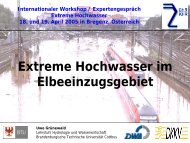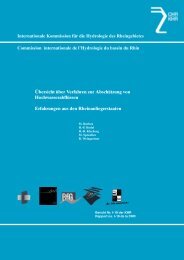ABSTRACTS 'Extreme Discharges' - CHR-KHR
ABSTRACTS 'Extreme Discharges' - CHR-KHR
ABSTRACTS 'Extreme Discharges' - CHR-KHR
Create successful ePaper yourself
Turn your PDF publications into a flip-book with our unique Google optimized e-Paper software.
Some comments on the estimation of extreme floods<br />
Annegret Thieken<br />
Bruno Merz<br />
Heiko Apel<br />
Engineering Hydrology, GeoForschungsZentrum Potsdam<br />
Telegrafenberg, D-14473 Potsdam, Germany<br />
thieken@gfz-potsdam.de<br />
The estimation of flood hazard is often based on an extreme value analysis of discharge data. Such estimations<br />
are, however, rather uncertain (e.g. Merz & Thieken, 2005). Fig. 1 shows that large uncertainty bounds result if<br />
various distribution functions are adapted to a series of annual maximum floods (from 1880 to 1999) at the Cologne<br />
gauge on the river Rhine. Therefore, the question arises how this uncertainty can be reduced. Two different<br />
approaches are followed up for the gauges Cologne and Rees on the river Rhine.<br />
At the Cologne gauge historic flood events listed in Krahe (1997) were considered. Flood events of 1497, 1342<br />
and 1374 with water levels (according to the current gauge level) of 11.50 m, 11.53 m, and 13.30 m, respectively,<br />
clearly exceed the largest observed flood events in the time period 1880 to 1999. Discharges were obtained<br />
using the current rating curve. Owing to the morphological and hydraulic changes in the river bed the<br />
calculated discharges are very uncertain.<br />
The return periods of these events were estimated following the guidelines of DVWK (1999). The results are<br />
given in Table 1. Thus, the largest flood of 1374 can be classified as a 1000-year flood. Its magnitude is well<br />
estimated by the Generalised Logistic, the Gumbel or the Log-normal distribution in Fig. 1.<br />
Furthermore, an upper bound was assessed using different methods: the classification of maximum floods of<br />
Francou & Rodier (1967), the estimation of floods with large return periods after Kleeberg & Schumann (2001)<br />
and an envelop curve of maximum observed floods using data of Stanescu (2002) and other sources. In addition,<br />
Lammersen (2004) assessed a maximum flood at the Cologne gauge by means of modelling techniques. The<br />
resulting values are summarised in Table 1. On the basis of these data some distribution functions shown in<br />
Fig. 1 can be ruled out, e.g. the Weibull distribution.<br />
At the Rees gauge that is situated downstream of the Cologne gauge the probabilistic model of Apel et al. (2004,<br />
2005) was applied. The model consists of a flood frequency analysis at the Cologne gauge, a generation of typical<br />
flood waves and discharges from the tributaries Ruhr and Lippe, a routing module as well as an estimation<br />
and simulation of possible levee breaches between the gauges Cologne and Rees.<br />
In Fig. 2 the flood frequency analysis for the Rees gauge is contrasted to the results of the probabilistic model of<br />
Apel et al. (2004, 2005). Since levee breaches are included in the probabilistic model, it is capable of calculating<br />
an upper bound of the flood discharge. The upper bound of the probabilistic model is consistent with the results<br />
of Lammersen (2002). However, the data and modelling requirements of the probabilistic model are lower.<br />
It is suggested that the results of flood frequency analyses should be complemented with simple estimation<br />
methods in order to reduce uncertainty. If more time and data are available a simple probabilistic model gives a<br />
good assessment of an upper bound of flood discharge.<br />
85





